To Tequila and beyond
Friday was a latish night, Jose, Sarah and Fernando were round to see what it was like living in a house with 4 bathrooms and no water. I’d spent the best part of the evening trying various raindances and even having a go at getting the hose pipe to reach the water tank on the roof and then the kitchen sink. With zero success. Anyroad, apart from the drought t’was a nice evening that ended a little late (02h30) given that we had to get ourselves to the meeting point near Plaza Galerias for 09h00. We were second to arrive there after Sarah and could easily have had another hour in bed as we waited for everyone to arrive. sometimes I forget we’re in Mexico. We got the directions and organised the purchase of essential supplies (beer, tequila, quesadilla/taco ingredients) and headed on down the road to Tequila.
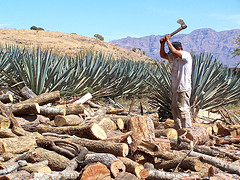 On the way, as I mentioned earlier, I was well chuffed to see my designs on billboards and the like, although they seemed to be outnumbered by other candidates with slogans like ‘Together we can do it’, ‘Trust in my decision’ and ‘Zero kidnapping’. Reminds me of the recurrent Monkey Dust sketch with Tony Blair intoning ‘A bicycle for every baby. multiple cures for cancer. an end to all suffering… etc’ over it. Anyroad, we couldn’t find Dr. Jaime’s farm so we parked and called for help/directions. 45 minutes of poring over Sarah’s celebrity gossip magazines later, the reinforcements arrived and we convoyed (our recently washed car) down a dirt track to the El Columpio tequila factory that’s jumped straight out of the 18th century. A bloke was outside cutting wood with an axe to fuel the ovens and inside they were unloaded the roasted piñas into the tahona. Hang on, here’s a quick Tequila Production 101:
On the way, as I mentioned earlier, I was well chuffed to see my designs on billboards and the like, although they seemed to be outnumbered by other candidates with slogans like ‘Together we can do it’, ‘Trust in my decision’ and ‘Zero kidnapping’. Reminds me of the recurrent Monkey Dust sketch with Tony Blair intoning ‘A bicycle for every baby. multiple cures for cancer. an end to all suffering… etc’ over it. Anyroad, we couldn’t find Dr. Jaime’s farm so we parked and called for help/directions. 45 minutes of poring over Sarah’s celebrity gossip magazines later, the reinforcements arrived and we convoyed (our recently washed car) down a dirt track to the El Columpio tequila factory that’s jumped straight out of the 18th century. A bloke was outside cutting wood with an axe to fuel the ovens and inside they were unloaded the roasted piñas into the tahona. Hang on, here’s a quick Tequila Production 101:
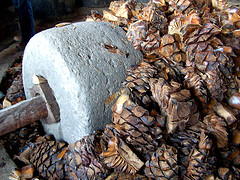 Agave plants take a good few years to grow. Some tell you 7, some 10 it all depends on who you ask. When they’re ripe the jimador comes along and cuts off the leaves (pencas) with his coa (sharp knife thing on a stick) leaving you with the agave pineapple (piña). A load of piñas (that start of white then get honey coloured) are cut into halves or smaller and slow-roasted for 24 hours in the aforementioned ovens. After that they’re usually shredded in a machine and squashed and the resultant mixture is fermented, then distilled, then barrelled.
Agave plants take a good few years to grow. Some tell you 7, some 10 it all depends on who you ask. When they’re ripe the jimador comes along and cuts off the leaves (pencas) with his coa (sharp knife thing on a stick) leaving you with the agave pineapple (piña). A load of piñas (that start of white then get honey coloured) are cut into halves or smaller and slow-roasted for 24 hours in the aforementioned ovens. After that they’re usually shredded in a machine and squashed and the resultant mixture is fermented, then distilled, then barrelled.
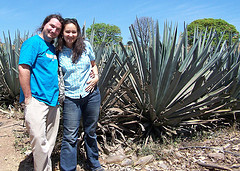 In the past, rather than putting the roasted agave through an industrial shredder, they were shoved into a circular mill called a tahona which has a huge stone grindstone dragged round in circles by a horse or donkey. Well this Columpio place (I looked up columpio and it means swing, not trampoline as we first thought. which is a shame.) uses the olde worlde tahona and horse set-up and looked fantastic in the medieval glow of the ovens. Dr. Jaime and the owner of the place gave us a guided tour of the room and then we tried the 100% (not-yet) tequila straight out of the still. It tastes of alcohol more than anything and needs to be mixed with a bit of water to let the agave taste come out. Still, it’s a great mouthwash and takes the edge off your hunger.
In the past, rather than putting the roasted agave through an industrial shredder, they were shoved into a circular mill called a tahona which has a huge stone grindstone dragged round in circles by a horse or donkey. Well this Columpio place (I looked up columpio and it means swing, not trampoline as we first thought. which is a shame.) uses the olde worlde tahona and horse set-up and looked fantastic in the medieval glow of the ovens. Dr. Jaime and the owner of the place gave us a guided tour of the room and then we tried the 100% (not-yet) tequila straight out of the still. It tastes of alcohol more than anything and needs to be mixed with a bit of water to let the agave taste come out. Still, it’s a great mouthwash and takes the edge off your hunger.
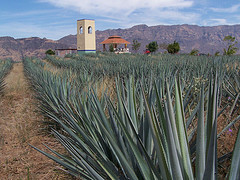 Next up over to Dr. Jaime’s agave plantation where they’ve been building a house, folly and dining patio. El buen doctor explained what the various varieties of agave were that he had growing there and took us on a tour round the fields pointing out the hijuelos (little clone plants that the agaves put out after 3 years of so, Sita took one home, ready to plant), telling us the local legends (ghosts of hanged men who didn’t want to fight for Santa Anna protect certain parts of the plantation), and identifying the colourfully-named weeds (tumbavaqueros, a local bindweed). All during this little tour we were sipping on the good stuff with the occasional beer for quenching thirst.
Next up over to Dr. Jaime’s agave plantation where they’ve been building a house, folly and dining patio. El buen doctor explained what the various varieties of agave were that he had growing there and took us on a tour round the fields pointing out the hijuelos (little clone plants that the agaves put out after 3 years of so, Sita took one home, ready to plant), telling us the local legends (ghosts of hanged men who didn’t want to fight for Santa Anna protect certain parts of the plantation), and identifying the colourfully-named weeds (tumbavaqueros, a local bindweed). All during this little tour we were sipping on the good stuff with the occasional beer for quenching thirst.
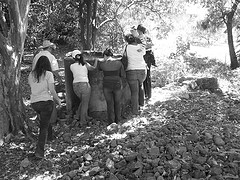 The next stage involved hopping in the back of el Dr’s 4×4 and heading off round the incredible little local villages to see the ruins of old tequila factories. A highlight for me there was seeing the women washing their clothes in the stream. The photos probably tell this part of the day best. We headed onwards through the fields and had another tequila stop under the shade of a huge tree and took a few photos, then on to more factory ruins. In the ruins there were tons of chile plants, apparently started from seeds in the salsa people eating tacos there.
The next stage involved hopping in the back of el Dr’s 4×4 and heading off round the incredible little local villages to see the ruins of old tequila factories. A highlight for me there was seeing the women washing their clothes in the stream. The photos probably tell this part of the day best. We headed onwards through the fields and had another tequila stop under the shade of a huge tree and took a few photos, then on to more factory ruins. In the ruins there were tons of chile plants, apparently started from seeds in the salsa people eating tacos there.
 Back to the dining place and we feasted on quesadillas and carne asada. Plus a bit of tequila for good measure. As the sun set, Dr. Jaime produced a rifle and everyone got a go at shooting targets in the field. What could possibly go wrong, as young sita said before waving the gun around. Sarah took a few photos, hopefully I’ll shove ’em up here soon. We went into the town center (knackered by now) found the hotel where sita’n’sarah’s friend works and got a couple of rooms. I tended to my sunburn and had a cold shower and then went out for double espressos. To celebrate El Dia de la Mujer (last Tuesday or so) the main square (zocalo) was full of little stores especially for the ladies offering such feminine delights as depilatory treatments, shopping bags, earrings and breakfast bars. Viva la igualdad. anyroad, we met up with agustin a kid from the tequila course and he took us round the bars of Tequila ending up eventually in El Cielo, a v. cool place with a view of the entire town center. I was knackered by then but it was a fun evening and a fantastic day. Tequila, photography, steak and guns.
Back to the dining place and we feasted on quesadillas and carne asada. Plus a bit of tequila for good measure. As the sun set, Dr. Jaime produced a rifle and everyone got a go at shooting targets in the field. What could possibly go wrong, as young sita said before waving the gun around. Sarah took a few photos, hopefully I’ll shove ’em up here soon. We went into the town center (knackered by now) found the hotel where sita’n’sarah’s friend works and got a couple of rooms. I tended to my sunburn and had a cold shower and then went out for double espressos. To celebrate El Dia de la Mujer (last Tuesday or so) the main square (zocalo) was full of little stores especially for the ladies offering such feminine delights as depilatory treatments, shopping bags, earrings and breakfast bars. Viva la igualdad. anyroad, we met up with agustin a kid from the tequila course and he took us round the bars of Tequila ending up eventually in El Cielo, a v. cool place with a view of the entire town center. I was knackered by then but it was a fun evening and a fantastic day. Tequila, photography, steak and guns.
 Sunday, in brief: fruit for brekky, drive home, fall asleep watching Pedro Paramo (1965), gigante, soup & spuds, Jose, 9 Canciones (reviewed right)… luckily next weekend might be a puente.
Sunday, in brief: fruit for brekky, drive home, fall asleep watching Pedro Paramo (1965), gigante, soup & spuds, Jose, 9 Canciones (reviewed right)… luckily next weekend might be a puente.
See the post below for links to the photos sets… or buy the calendar come october 🙂
So, would you want to trade lives for a bit? I don’t much care for tequila (I prefer the distinctive hallucinations and vomitus of mescal personally), but I can learn.
Erm, thanks but no thanks. Much as I love Massachusetts and its 3.4 days of Spring… You’re welcome to visit, but no vomitusing in the house, mind 🙂